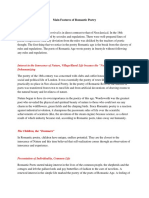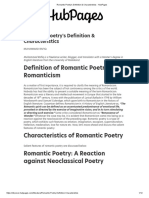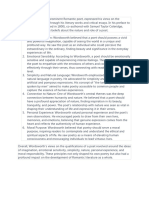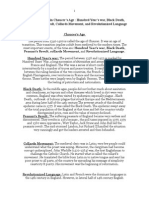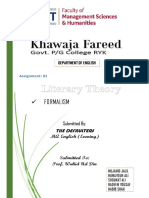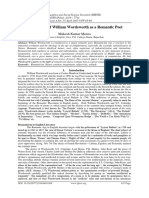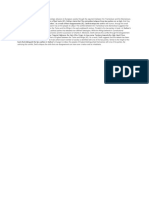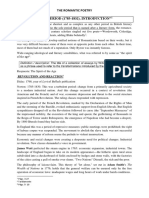0% found this document useful (0 votes)
1K views13 pagesPerception of Nature of Different Romantic Poets
This document discusses the concept of nature in Romantic poetry. It provides an overview of Romanticism as a literary movement, highlighting key figures like Jean-Jacques Rousseau and influences like the American and French Revolutions. It then examines how Romantic poets like William Wordsworth, Samuel Taylor Coleridge, William Blake, Lord Byron, John Keats, and Percy Bysshe Shelley portrayed nature in their works. The document also discusses the Romantic concept of pantheism and how it shaped these poets' perspectives on nature. Finally, it analyzes Wordsworth's treatment of nature in select poems as an example.
Uploaded by
Atif HayatCopyright
© © All Rights Reserved
We take content rights seriously. If you suspect this is your content, claim it here.
Available Formats
Download as PDF, TXT or read online on Scribd
0% found this document useful (0 votes)
1K views13 pagesPerception of Nature of Different Romantic Poets
This document discusses the concept of nature in Romantic poetry. It provides an overview of Romanticism as a literary movement, highlighting key figures like Jean-Jacques Rousseau and influences like the American and French Revolutions. It then examines how Romantic poets like William Wordsworth, Samuel Taylor Coleridge, William Blake, Lord Byron, John Keats, and Percy Bysshe Shelley portrayed nature in their works. The document also discusses the Romantic concept of pantheism and how it shaped these poets' perspectives on nature. Finally, it analyzes Wordsworth's treatment of nature in select poems as an example.
Uploaded by
Atif HayatCopyright
© © All Rights Reserved
We take content rights seriously. If you suspect this is your content, claim it here.
Available Formats
Download as PDF, TXT or read online on Scribd
/ 13
